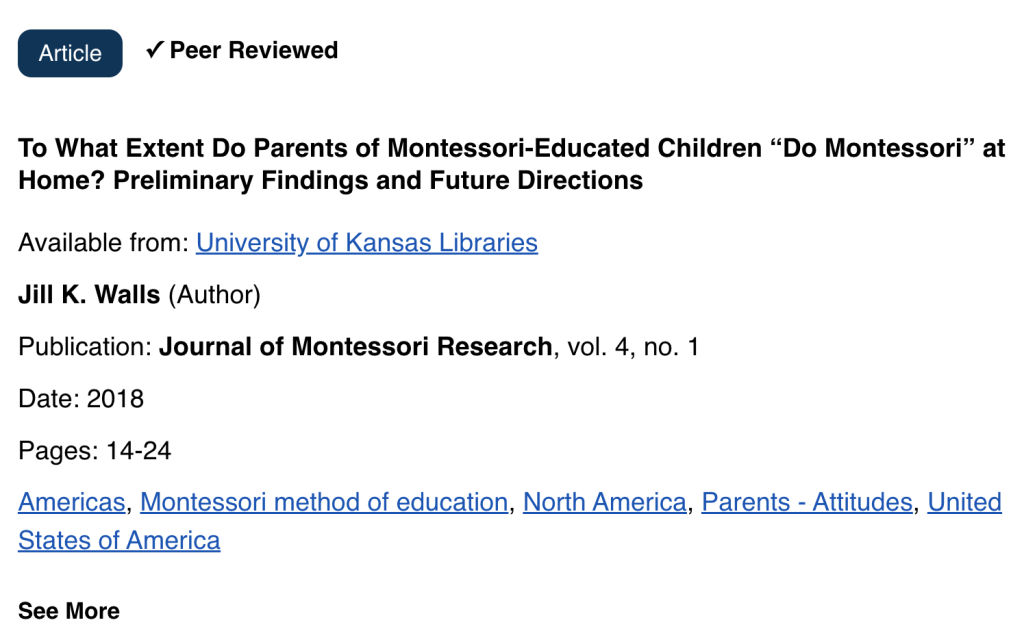“How many articles in the Montessori Bibliography Online are peer reviewed?” This is the question that a number of individuals have posed to me. After considerable evaluation and problem solving I was able to identify an approach to collate this information and a method for recording it within entries of the database.
The method I employed to determine whether a magazine or journal article is from a peer reviewed publication initially relied on the following steps:
-
- Determine ISSN for publication and add it to applicable entries in the database.
-
- Determine Peer Review status of publication and demarcate peer reviewed sources within the database.
It may be of interest to know that I utilize Zotero to organize and catalog all of the entries within the Montessori Bibliography Online and I use a plugin called Zutilo to perform some more advanced operations.
Determine ISSN
In order to identify the ISSN for publications referenced in all of the article entries I relied on three resources: ISSN Portal, Ulrichsweb, and WorldCat. Once an ISSN was identified, I added it to the applicable entries in the database (in the “ISSN” field of Zotero). Not all publications will have an ISSN: some publications pre-date the ISSN standard, other publications have not applied for an ISSN. I am operating under the impression that all peer reviewed publications will have an ISSN.
Approximately 77% (31,842) of all entries in the Montessori Bibliography Online are magazine/journal entries and I was able to identify ISSNs for 61% (19,564) of these entries. These article entries are from 1,694 (based on ISSN) or 2,636 (based on publication title) unique publications. This discrepancy is due to the fact that not all publications have ISSNs and a publication can have the same ISSN but then change title.
Determine peer review status
After identifying the ISSN for as many entries as possible, the next step was determining the review status of the publications. In order to achieve this I relied on a few methods. Firstly, I consulted Ulrichsweb which indicates if publications are peer reviewed (aka “refereed”). Additionally, I consulted publication websites to see how they present their review process. It’s important to note that “peer review” is generally synonymous with double-blind review, blind review, and refereed. Once I determined whether a publication employed peer review or not I added this demarcation to the applicable entries in the database.
This specifically resulted in repurposing the “journalAbbreviation” field in Zotero to capture the peer review status data. Therefore, if I was able to determine that a publication is peer reviewed then a “Yes” was added to the “journalAbbreviation” field in the respective database entries.
Peer review statistics
1,972 of magazine/journal article entries in the database are from peer reviewed publications (as of October 19, 2023).
5.58% of all article entries are from peer reviewed sources.
The chart above indicates a clear exponential upward trajectory beginning in the early 2000s. This sharp increase is likely in part due to changes in scholarly communication – such as the introduction of electronic/online journals – during the past 20 to 40 years. Other similar factors also may partially explain this uptick. Thus, it’s difficult to say whether this trend indicates an increase in research related to Maria Montessori and/or Montessori education.
Conclusion
These numbers may under-represent the actual figure because determining peer review status of historical publications or publications which are no longer in print is quite difficult. All this to say, I’m not sure if any meaningful conclusions can be drawn from these figures, but I think it at least provides some insight into the Montessori Bibliography Online dataset.
Regardless, now that this data has been captured within the database it can be displayed in records on the search results page. For any article that is from a peer reviewed source, the record will include a “Peer Reviewed” label as illustrated in the image below.

